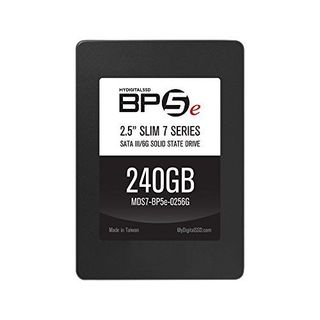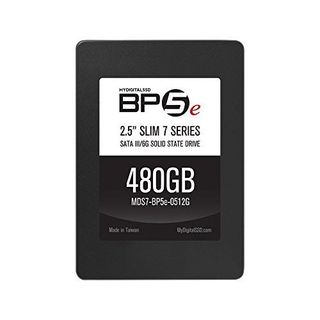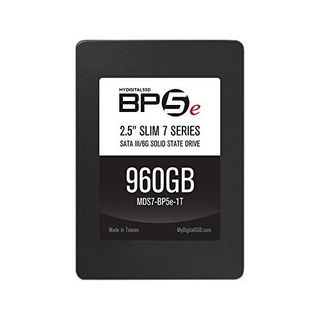MyDigitalSSD BP5e Low-Cost TLC SSD Review
Why you can trust Tom's Hardware
Mixed Workloads And Steady State
80 Percent Sequential Mixed Workload
Our mixed workload testing is described in detail here, and our steady state tests are described here.
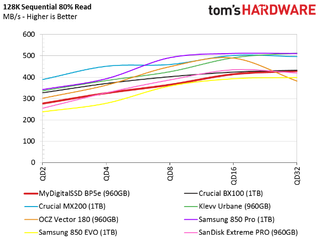
Several of the TLC-based SSDs struggle with sequential mixed workloads. SATA is a half-duplex interface, so it can't read and write at the same time. Native command queuing was implemented to help mixed workload performance by stacking and running operations in an optimized order.
80 Percent Random Mixed Workload
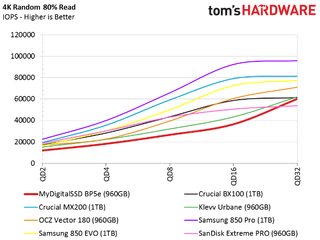
Those performance issues apply to random transfers as well, and are compounded by the small 4KB blocks we're moving around.
Sequential Steady State



The upswing we see when the graph gets to 100 percent sequential writes shows just how much Phison has improved performance with TLC flash. If you look back at the Adata SP550 review, there are several examples of what we more commonly associate with TLC in steady state using the same test. After the 80 percent read measurement, most TLC-based drives level out under 100 MB/s and never recover. Not only does the BP5e stage a recovery, but it also keeps performance north of 200 MB/s through most of our benchmark.
Random Write Steady State


There are two interesting take-aways, one from each random steady state chart. In the first test, where we see preconditioning happen before the measurement, the BP5e has two towering spikes where the SLC buffer flushes and then starts accepting 4KB blocks again. In the second chart, we see the BP5e drop to very low levels. Unlike the 960GB OCZ Vector 180, MyDigitalSSD's drive does not fall to zero (though it does dip to around 250 IOPS, about the same as a high-performance mechanical disk). Fortunately, you will never see a steady state condition under random I/O without running a database server on the drive.
Current page: Mixed Workloads And Steady State
Prev Page Four-Corner Performance Testing Next Page Real-World Software PerformanceStay on the Cutting Edge
Join the experts who read Tom's Hardware for the inside track on enthusiast PC tech news — and have for over 25 years. We'll send breaking news and in-depth reviews of CPUs, GPUs, AI, maker hardware and more straight to your inbox.
-
That price is incredible. I remember my first SSD, when it was ONLY 2$/GB. If I was buying today, I'd get 6 * 480 GB drives, and run them in a btrfs raid, just for plain storage. For anyone buying today, for their own use, it makes no sense to go mechanical.Reply
Can't wait for the next generation Samsung 3d nand. -
Nintendork It makes no sense to raid 0 SSD's, you won't improve random 4k performance AND YOU WONT IMPROVE LATENCY (wich is what it makes SSDs faster than a HDD). You're simply adding more fail %.Reply
NVMe SSD's barely improve those things. We will need intel's 3D Xpoint (or similar tech) for another massive gain in those things.
-
cryoburner ReplyFor anyone buying today, for their own use, it makes no sense to go mechanical.
The price might be relatively good for an SSD, but that's still 25 cents per gigabyte. Mechanical desktop drives, by comparison, are generally around 3 to 5 cents per gigabyte, which for someone needing multiple terabytes for bulk storage or backup redundancy can really add up. For many purposes like storing video, there won't be much of a performance difference either.
Of course, most people probably don't even need 1 TB of storage in their system, and 240 GB of storage could be more than enough for them, in which case doing away with a mechanical drive in favor of a comparably priced but lower-capacity SSD could make a lot more sense. -
CalHob Interesting to see TLC continuing to lead the value market with further refinement of error correction technique while still developing improvements in performance.Reply
As a REVIEW, it comes up short in evaluting against products in the same performance and price segment. As I started to read the review, I kept looking for Tom's Best Pick 1TB Budget Buy, the Mushkin Reactor, to be included. And, there are also other TLC based drives, that Tom's has reviewed in other capacities, that should be included. In my mind, the review should have included at a minimum: Samsung 850 EVO 1 TB (as the TLC performance reference), ADATA SP550 960GB, and Mushkin Reactor 1TB. At this point in time, the MyDigitalSSD, ADATA and Mushkin drives are competing at the same price point on Amazon and Newegg. Comparing these drives would have brought more meaning to the review. -
photonboy Nintendork,Reply
There are reasons to RAID0 an SSD. For example, working with video can benefit. Plenty of articles with number to prove that, and also to prove that for MOST things real-world benefits aren't there. -
rhysiam How likely is it that other Phison S10 drives have benefited significantly from performance-related firmware updates since release? It seems like this drive is better than the competition primarily because of the more mature firmware, but I'm wondering if other drives have also improved since release.Reply -
CRamseyer ReplyInteresting to see TLC continuing to lead the value market with further refinement of error correction technique while still developing improvements in performance.
As a REVIEW, it comes up short in evaluting against products in the same performance and price segment. As I started to read the review, I kept looking for Tom's Best Pick 1TB Budget Buy, the Mushkin Reactor, to be included. And, there are also other TLC based drives, that Tom's has reviewed in other capacities, that should be included. In my mind, the review should have included at a minimum: Samsung 850 EVO 1 TB (as the TLC performance reference), ADATA SP550 960GB, and Mushkin Reactor 1TB. At this point in time, the MyDigitalSSD, ADATA and Mushkin drives are competing at the same price point on Amazon and Newegg. Comparing these drives would have brought more meaning to the review.
When Adata released the SP550 drives for review the 960GB model was not ready. We simply do not have that drive. We built a low cost SSD performance database for each of the other capacity sizes and you see similar products grouped together in those reviews. From Computex (last June) until only recently many of the TLC-based drives were not available. In short, we're working on it.
This review was put together before the OCZ Trion 150 arrived, the two new PNY drives, the new Corsair LE and the stuff we can't talk about yet (but soon).
The Best of Monthly (what I call it) goes back to being a monthly release starting this week. Several of you read and comment on my reviews so you are here quite a bit. I plan to utilize the monthly column to recap the reviews for the month and give some insight into what to expect for the next month. I've also added several new columns. Expect to see entry-level, mainstream, and premium drives for each capacity as well as new PCIe and All-in-One RAID drives.
-
razor512 Minimal price reduction for a massive reduction in write endurance. It is a bad value unless they can reduce their price by at at least 40% (to match the data density gains that they get from TLC).Reply -
FilipHappy ReplyWhen Adata released the SP550 drives for review the 960GB model was not ready. We simply do not have that drive. We built a low cost SSD performance database for each of the other capacity sizes and you see similar products grouped together in those reviews. From Computex (last June) until only recently many of the TLC-based drives were not available. In short, we're working on it.
This review was put together before the OCZ Trion 150 arrived, the two new PNY drives, the new Corsair LE and the stuff we can't talk about yet (but soon).
The Best of Monthly (what I call it) goes back to being a monthly release starting this week. Several of you read and comment on my reviews so you are here quite a bit. I plan to utilize the monthly column to recap the reviews for the month and give some insight into what to expect for the next month. I've also added several new columns. Expect to see entry-level, mainstream, and premium drives for each capacity as well as new PCIe and All-in-One RAID drives.
Even though - good job! The review is useful and one gets a nice overall view. Thank you. :)
May I ask for your personal opinion? As a budget 1TB SSD - would you buy Mushkin Reactor 1TB, MyDigitalSSD BP5e 960GB, Adata SP550 960Gb, or wait for new releases (or wait even until june)? -
George_71 I hope "mydigitalssd" has finally gotten their stuff together. I bought a BP4e mSATA drive about a year or so ago. It failed constantly. I contacted "mydigitalssd", RMAed the drive. MDSSD replaced the drive. The replacement drive has the same issues.Reply
There is a cost/benefit that needs to be taken into account when dealing with drives. This is a low cost option,however do you really want to take the chance? I am sorry i did.
